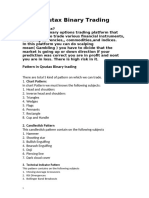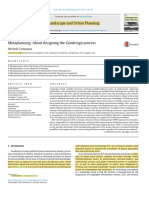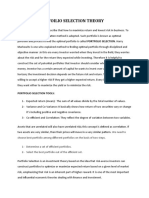0 ratings0% found this document useful (0 votes)
213 viewsSupport and Resistance Presentation
Support and Resistance Presentation
Uploaded by
nafik65299The document discusses support and resistance levels in financial markets. It defines support as a price level where the price stops dropping due to increased demand, and resistance as a price level where the price stops rising due to increased supply. It provides examples of how to trade breakouts and breakdowns of support and resistance levels by entering trades after the levels are retested and confirmed. It also gives tips for identifying and trading support and resistance levels, such as waiting for confirmation before entering and not placing stop losses directly at obvious support/resistance zones.
Copyright:
© All Rights Reserved
Available Formats
Download as PDF, TXT or read online from Scribd
Support and Resistance Presentation
Support and Resistance Presentation
Uploaded by
nafik652990 ratings0% found this document useful (0 votes)
213 views35 pagesThe document discusses support and resistance levels in financial markets. It defines support as a price level where the price stops dropping due to increased demand, and resistance as a price level where the price stops rising due to increased supply. It provides examples of how to trade breakouts and breakdowns of support and resistance levels by entering trades after the levels are retested and confirmed. It also gives tips for identifying and trading support and resistance levels, such as waiting for confirmation before entering and not placing stop losses directly at obvious support/resistance zones.
Copyright
© © All Rights Reserved
Available Formats
PDF, TXT or read online from Scribd
Share this document
Did you find this document useful?
Is this content inappropriate?
The document discusses support and resistance levels in financial markets. It defines support as a price level where the price stops dropping due to increased demand, and resistance as a price level where the price stops rising due to increased supply. It provides examples of how to trade breakouts and breakdowns of support and resistance levels by entering trades after the levels are retested and confirmed. It also gives tips for identifying and trading support and resistance levels, such as waiting for confirmation before entering and not placing stop losses directly at obvious support/resistance zones.
Copyright:
© All Rights Reserved
Available Formats
Download as PDF, TXT or read online from Scribd
Download as pdf or txt
0 ratings0% found this document useful (0 votes)
213 views35 pagesSupport and Resistance Presentation
Support and Resistance Presentation
Uploaded by
nafik65299The document discusses support and resistance levels in financial markets. It defines support as a price level where the price stops dropping due to increased demand, and resistance as a price level where the price stops rising due to increased supply. It provides examples of how to trade breakouts and breakdowns of support and resistance levels by entering trades after the levels are retested and confirmed. It also gives tips for identifying and trading support and resistance levels, such as waiting for confirmation before entering and not placing stop losses directly at obvious support/resistance zones.
Copyright:
© All Rights Reserved
Available Formats
Download as PDF, TXT or read online from Scribd
Download as pdf or txt
You are on page 1of 35
With Jacob Canfield
What Will You Learn Today?
• What support and resistances are
• How to trade them
• 5 Key Tips For Using
Support/Resistance
• Live Q&A With Examples
Support & Resistance
Why is Support and Resistance so Important?
Represent significant turn around
points in the market and mark areas of
Supply/Demand In the markets
Definition of a Support
A support is a level in which the price
will stop dropping due to an increase in
demand.
Example of a Support
Definition of a Resistance
A resistance is a level in which the price
will stop rising due to an increase in
supply.
Example of a Resistance
What can act as a Support or as a Resistance?
➢ Moving averages
➢ Fibonacci retracement levels
➢ Prior price action levels
➢ Pattern formations
➢ Buy and Sell walls
➢ VPVR
➢ VWAP
➢ Daily, Monthly, Weekly, Annual, Quarterly, Hourly
Opens/Closes
What is a Support and Resistance flip?
➢ A support and resistance flip is when old support
becomes new resistance or when old resistance becomes
new support.
➢ It is commonly referred to as an “S/R flip”
Example of an S/R flip
How do I trade Support zones?
➢ One popular method of trading
support zones is by entering on Entering on confirmation:
confirmation.
➢ Waiting for a zone to prove it will
hold as support is critical; as if
your entries are placed at support
and it doesn’t hold, you will be
incurring a loss and or risk having
your stop loss activated.
Why would I not put an order right at a Support zone?
Not entering on confirmation:
➢ As shown by AMB/BTC, waiting
for confirmation of the support
holding is critical.
➢ We can see it held the 1600 level
twice previously, and had you
placed buys at the 1600 after the
fact, you would’ve incurred a
loss and or had your stop loss
hit when it retested that zone
the third time.
How do I trade Break-outs?
Entering on confirmation after a break-out:
➢ In this example on ETH/USD, we can see
price finds initial resistance at the red box on
the left.
➢ After running sideways underneath
resistance, price eventually breaks up above
resistance as shown by the yellow box in the
middle.
➢ Once price starts to correct, we would look
to enter near the green box on the right as
we want to see old resistance become new
support.
➢ If price holds the green box, it would confirm
the S/R flip, and we can then enter the trade.
Had we done that here, we would’ve made
50-60%.
How do I trade Break-outs?
In this example on ETH/USD, we can see
price finds initial resistance at the red box on
the left.
After running sideways underneath
resistance, price eventually breaks up above
resistance as shown by the yellow box in the
middle.
Once price starts to correct, we would look
to enter near the green box on the right as
we want to see old resistance become new
support.
If price holds the green box, it would confirm
the S/R flip, and we can then enter the trade.
Had we done that here, we would’ve made Entering on confirmation after a break-out
50-60%.
How do I trade Resistance zones?
➢ One popular method of trading resistance Selling on confirmation:
zones is by selling on confirmation.
➢ Waiting for a zone to prove it will hold as
resistance is critical; as if it doesn’t, you risk
selling too early and could potentially be
missing out on further percentage gains.
➢ As shown here by ETH/USD, we see one wick
rejection, sideways consolidation, another
retest up into the white box, right into
another wick rejection.
➢ After the second wick rejection, we would sell
out for a profit as the zone has confirmed it
will act as resistance.
How do I trade Resistance zones?
One popular method of trading resistance Selling on confirmation:
zones is by selling on confirmation.
Waiting for a zone to prove it will hold as
resistance is critical; as if it doesn’t, you risk
selling too early and could potentially be
missing out on further percentage gains.
As shown here by ETH/USD, we see one wick
rejection, sideways consolidation, another
retest up into the white box, right into
another wick rejection.
After the second wick rejection, we would sell
out for a profit as the zone has confirmed it
will act as resistance.
How do I trade Break-downs?
➢ In this example on ICX/BTC, we can see price Entering on confirmation after a break-down:
was holding support on this green box on
the left.
➢ However, after price began to decline, we
eventually saw this support break as shown
by the small yellow box in the middle.
➢ Shortly after breaking below the prior
support zone, price moves up to retest it as
new resistance, and we see price get swiftly
rejected confirming the S/R flip.
➢ If we wanted to buy ICX lower, we would
close our position out after the rejection and
look to enter lower. Had we done that here,
we would’ve avoided an additional 12% loss.
How do I trade Break-downs?
Entering on confirmation after a break-down:
In this example on ICX/BTC, we can see price
was holding support on this green box on
the left.
However, after price began to decline, we
eventually saw this support break as shown
by the small yellow box in the middle.
Shortly after breaking below the prior
support zone, price moves up to retest it as
new resistance, and we see price get swiftly
rejected confirming the S/R flip.
If we wanted to buy ICX lower, we would
close our position out after the rejection and
look to enter lower. Had we done that here,
we would’ve avoided an additional 12% loss.
An example of taking a Short on a Break-down:
Entering a Short on confirmation after a break-down:
➢ In this example on XBT/USD, one
could enter a short position after
confirmation of old support
becoming new resistance.
➢ Had you taken shorts at either of
the red X’s, you could’ve made a
decent profit on each depending
on how much leverage you used.
An example of taking a Short on a Break-down:
Entering a Short on confirmation after a break-down:
In this example on XBT/USD, One
could enter a short position after
confirmation of old support
becoming new resistance.
Had you taken shorts at either of
the red X’s, you could’ve made a
decent profit on each depending
on how much leverage you used.
What is meant by Daily/Weekly/Monthly
Support & Resistance?
➢ Drawing Major Support and Resistance zones Identify M/W/D S/R Levels/Zones
from higher time frames first can help
eliminate the noise of lower time frame levels
➢ Monthly levels where price found a reversal
is a great place to start and then zoom in to
Weekly and Daily levels afterwards
➢ Daily and Weekly levels can be hidden by
Monthly levels just as Daily levels can be
hidden by Weekly levels
➢ After the second wick rejection, we would sell
out for a profit as the zone has confirmed it
will act as resistance.
Daily/Weekly/Monthly Support & Resistance
You can clean this up by identifying zones
➢ As you can see it can become very messy
and hard to interpret what is on the chart
➢ This can be remedied by identifying clear
zones where there are multiple levels present
in a small area
➢ This way the overlap from a Monthly or a
Weekly can be identified as one clear zone of
Support or Resistance
What else should I know about Support and
Resistance?
➢ Support and Resistance are not exact numbers; they are
more generalized “zones”
➢ Support and Resistance zones on higher time-frames are
often more reliable then those on smaller time-frames.
➢ Support and Resistance are not limited to just price
action; they occur on indicators like the RSI as well.
Using Support/Resistance with a Stop Loss
➢ When using a stop loss on a ‘long’ trade, meaning you
think the price will go up, we don’t place our stop
directly at a support level.
➢ Instead, you place it BELOW the support level so that
you don’t exit the trade prematurely.
➢ If in a short, you place your stop loss ABOVE the
resistance level to not get taken out prematurely.
Key Tips For Support and Resistance?
➢ Support and Resistance can be very ‘obvious’
zones that we’ll often see break to ‘trap’
people into being on the wrong side.
➢ This is why we WAIT for confirmation of the
level to hold before entering a trade.
KEY TIP #1
➢ The More Times A Support Or Resistance Is
Tested, The WEAKER It Becomes
➢ Reason: They are supply and demand zones
and when they are tested multiple times,
they run out of buying and selling pressure.
KEY TIP #2
➢ Higher lows INTO resistance usually result in
a breakout. (Ascending triangle formation.)
➢ Lower highs into support usually result in a
break down. (Descending triangle formation)
KEY TIP #3
➢ Don’t place your stop loss at obvious
support and resistance levels.
➢ Place them a good distance away so that
you don’t get your stop loss hunted.
➢ You can also wait for a candle CLOSING
before manually closing your trade.
KEY TIP #4
➢ Consolidation against support and resistance
usually results in a breakout / breakdown.
➢ Supports have higher probability to break in
a downtrend.
➢ Resistance have higher probability to break
in uptrends.
KEY TIP #5
➢ You’re going to get the best risk/reward by
shorting resistance and longing support.
➢ Trading mid-range will result in much lower
risk/reward on your trades.
Do You Want To Learn
How To Trade Crypto From a
Professional trader?
Click Here To Learn More
Join The Next 21 Day Trading Foundation Masterclass
Challenge
You might also like
- Forexbee Co Candlestick Patterns Dictionary PDFDocument20 pagesForexbee Co Candlestick Patterns Dictionary PDFDaffy JackNo ratings yet
- Candlestick Exam (30marks)Document35 pagesCandlestick Exam (30marks)Justine Jose100% (1)
- IQ TRADER CANDLESTICK BOOK (English Edition)Document57 pagesIQ TRADER CANDLESTICK BOOK (English Edition)a baluNo ratings yet
- All Double Candlesticks Pattern PDF by Optrading00 TelegramDocument23 pagesAll Double Candlesticks Pattern PDF by Optrading00 TelegramSamitm Tamhankar100% (1)
- CandleStick Patterns ListDocument23 pagesCandleStick Patterns ListZaid Ahmed50% (2)
- Bearish+Engulfing+CandleStick+Pattern Double+Candlestick+Pattern+ +Document5 pagesBearish+Engulfing+CandleStick+Pattern Double+Candlestick+Pattern+ +Ting Zhi Peng (Ethan)No ratings yet
- 3.all About CandlesticksDocument39 pages3.all About Candlestickstrisha chandroo100% (4)
- Price Action CheatsheetDocument22 pagesPrice Action CheatsheetCapitanu Iulian100% (3)
- SAP IS Oil TerminologyDocument5 pagesSAP IS Oil Terminologympsurender100% (2)
- Property Tax ReceiptDocument1 pageProperty Tax Receiptsayan.official833100% (1)
- Price Action Patterns 2.0 EbookDocument36 pagesPrice Action Patterns 2.0 Ebooksntrader461No ratings yet
- Technical Anls Part 2Document66 pagesTechnical Anls Part 2sujal JainNo ratings yet
- Chart PattrenDocument5 pagesChart Pattrenmouddenzayd100% (2)
- Candle Pattern ForexDocument48 pagesCandle Pattern ForexAli Ghulam100% (2)
- Ultimate Price Action 2.0 - Day 2Document70 pagesUltimate Price Action 2.0 - Day 2nazimvmNo ratings yet
- Candlestick PatternDocument6 pagesCandlestick Patterntraining division100% (1)
- Candlestick Patterns Lesson 01Document10 pagesCandlestick Patterns Lesson 01Malshan kawindaNo ratings yet
- Revesable Candle Stick PatternDocument27 pagesRevesable Candle Stick PatternrgautomobilesstockNo ratings yet
- Price Action Key Level Break HH RejectionDocument2 pagesPrice Action Key Level Break HH RejectionRehan Khan100% (1)
- Bearish Inverted Hammer Candlestick PatternDocument6 pagesBearish Inverted Hammer Candlestick PatternTing Zhi Peng (Ethan)No ratings yet
- Trading (Basic)Document7 pagesTrading (Basic)gurjar harshNo ratings yet
- Price Action Smart Money Trading Strategy Using Channels, Support Resistance, Fibonacci, Market Stucture, Trendlines,... (King, Profit) (Z-Library)Document87 pagesPrice Action Smart Money Trading Strategy Using Channels, Support Resistance, Fibonacci, Market Stucture, Trendlines,... (King, Profit) (Z-Library)Tooba SaifNo ratings yet
- Summary Candle PatternsDocument6 pagesSummary Candle PatternsmejiasidNo ratings yet
- Qoutax Binary TradingDocument7 pagesQoutax Binary Tradingabashamza27967% (3)
- (4194) Quotex Bot Trading Binary Bot Signls 99% Working - YouTubeDocument1 page(4194) Quotex Bot Trading Binary Bot Signls 99% Working - YouTubeanasytxemp4231No ratings yet
- Edit - The Monster Guide To Candlestick PatternsDocument29 pagesEdit - The Monster Guide To Candlestick PatternsVatsal Parikh100% (1)
- 10 Binary Options StrategiesDocument26 pages10 Binary Options Strategiesvideo lyric100% (1)
- Topics 02Document5 pagesTopics 02Prince FahimNo ratings yet
- Price Action Simplified by EmzetDocument25 pagesPrice Action Simplified by EmzetEmzet PremiseNo ratings yet
- Candlestick PaternsDocument12 pagesCandlestick Paternsdarshan wareNo ratings yet
- Candlestick Pattern @the - Bullish - TraderDocument29 pagesCandlestick Pattern @the - Bullish - Tradermursal.naqshbandi.mnNo ratings yet
- The Price Action Cheat SheetDocument22 pagesThe Price Action Cheat SheetAj choudhary100% (2)
- Candlestick Charting PrimerDocument131 pagesCandlestick Charting PrimerScorchNo ratings yet
- The Lazy Trader GuideDocument15 pagesThe Lazy Trader GuideAlex Adallom75% (4)
- Cheat Sheet CandlesticksDocument1 pageCheat Sheet CandlesticksRaviVermaNo ratings yet
- Charts Pattern For PrintoutDocument7 pagesCharts Pattern For PrintoutHarshaaal100% (3)
- Breakout Trading Strategies Quick GuideDocument10 pagesBreakout Trading Strategies Quick GuideAdam Cho0% (1)
- Bullish Reversal Candlestick PatternsDocument42 pagesBullish Reversal Candlestick PatternsMaham BaqaiNo ratings yet
- LMBO Candlestick Patterns GuideDocument33 pagesLMBO Candlestick Patterns GuideSangeen Khan100% (4)
- Bull Trap Chart PatternDocument3 pagesBull Trap Chart PatternVanessa SchultzNo ratings yet
- Ultimate 4 Step Support and Resistance Trading Strategy 644a934aDocument21 pagesUltimate 4 Step Support and Resistance Trading Strategy 644a934auninfor informatica71% (7)
- Bearish Candle - Stick PatternDocument48 pagesBearish Candle - Stick Patternpdhamgaye49No ratings yet
- Candlestick Patterns - PDFDocument24 pagesCandlestick Patterns - PDFUdit Divyanshu100% (1)
- Candle PsychologyDocument1 pageCandle Psychologyabdullahlabib073100% (1)
- Venue FL & N Line 23MY IncrementalDocument4 pagesVenue FL & N Line 23MY IncrementalManish GadeNo ratings yet
- Bullish Candle:: We Will Be Learning The Following 1.marubozuDocument21 pagesBullish Candle:: We Will Be Learning The Following 1.marubozuManoj KumarNo ratings yet
- Candel Stick Pattern DoubleDocument23 pagesCandel Stick Pattern Doublergautomobilesstock100% (1)
- A Price Action Traders Guide To Supply and DemandDocument17 pagesA Price Action Traders Guide To Supply and Demandmohamed100% (11)
- FMC Derive Price Action GuideDocument50 pagesFMC Derive Price Action GuideTafara MichaelNo ratings yet
- All 63 Candlestick Patterns Explained in Details & Performance DataDocument13 pagesAll 63 Candlestick Patterns Explained in Details & Performance DataROCK Boy0% (2)
- Binary Trading Crash CourseDocument21 pagesBinary Trading Crash Coursearifmuneeb0510% (1)
- التحليل الفني للشموع اليابانيةDocument22 pagesالتحليل الفني للشموع اليابانيةbousdjiramouradNo ratings yet
- Trading PatternsDocument1 pageTrading Patternskunalsingh74644No ratings yet
- Guide To Trading Using Price Action and Candlesticks On IQ OptionDocument11 pagesGuide To Trading Using Price Action and Candlesticks On IQ OptionTathego GomolemoNo ratings yet
- 12+ Candlestick Formations Every Technical Trader Should KnowDocument37 pages12+ Candlestick Formations Every Technical Trader Should KnowDark BlackNo ratings yet
- Price Action Cheatsheet PDFDocument19 pagesPrice Action Cheatsheet PDFcRi SocietyNo ratings yet
- Price Action Trading Reversal and Continuation Patterns How To ReadDocument33 pagesPrice Action Trading Reversal and Continuation Patterns How To Readshreyanmishra43100% (1)
- Quotex An Innovative Platform For Online Investment 2Document1 pageQuotex An Innovative Platform For Online Investment 2prokashbarai1977No ratings yet
- Binary Option Trading: Introduction to Binary Option TradingFrom EverandBinary Option Trading: Introduction to Binary Option TradingRating: 5 out of 5 stars5/5 (1)
- PRO DutiesDocument4 pagesPRO DutiesRiaz kingNo ratings yet
- 1 Introduction Lesson 1 GEC 3Document33 pages1 Introduction Lesson 1 GEC 3Jose Carlo ParangueNo ratings yet
- n22 Business Management HL p2Document8 pagesn22 Business Management HL p2master.moise10No ratings yet
- Lot Sizing With Multiple Products Ordered and Delivered SeperatelyDocument6 pagesLot Sizing With Multiple Products Ordered and Delivered SeperatelyShivamKhareNo ratings yet
- Director Operations in Chicago IL Resume Jim SchroederDocument2 pagesDirector Operations in Chicago IL Resume Jim SchroederJimSchroeder2No ratings yet
- Abduselam Aliyi Project ProposalDocument67 pagesAbduselam Aliyi Project ProposalAbduselam AliyiNo ratings yet
- Life Cycle Analysis AssignmentDocument2 pagesLife Cycle Analysis AssignmentMadison BoatlerNo ratings yet
- Project Communication Plan: Project Title: Project Manager: Executive Sponsor: Principal Stakeholder: DateDocument5 pagesProject Communication Plan: Project Title: Project Manager: Executive Sponsor: Principal Stakeholder: DateChi NonsoNo ratings yet
- Ing BankDocument4 pagesIng BankKrati BhargavaNo ratings yet
- 2021 CMCI LDCS - SrsDocument73 pages2021 CMCI LDCS - SrsAnn ManaloconNo ratings yet
- Q.1 List and Explain in Brief The Methods of Selection of ConsultantsDocument8 pagesQ.1 List and Explain in Brief The Methods of Selection of ConsultantsLiju Koshy100% (1)
- ch7 TBDocument10 pagesch7 TBZahraa PervizNo ratings yet
- 03 - Metaplanning About Designing The Geodesign ProcessDocument11 pages03 - Metaplanning About Designing The Geodesign ProcessThaise SutilNo ratings yet
- ENG Gecko Digitech PresentationDocument10 pagesENG Gecko Digitech PresentationBertolino DanielNo ratings yet
- Kasus Bagian 4-Kasus Dian Theatre CoDocument4 pagesKasus Bagian 4-Kasus Dian Theatre CoKevin Yudha PradityaaNo ratings yet
- Business With: Why Do RosenbauerDocument2 pagesBusiness With: Why Do RosenbauerLaurensNLNo ratings yet
- Indian IT Industry AnalysisDocument9 pagesIndian IT Industry AnalysisprasannasaaiNo ratings yet
- Statement-14123739 TRANSFEREE JasonBrettWatsonDocument4 pagesStatement-14123739 TRANSFEREE JasonBrettWatsonJason Brett WatsonNo ratings yet
- Portfoilio Selection TheoryDocument3 pagesPortfoilio Selection TheoryMufti AliNo ratings yet
- Technology Ventures From Idea To Enterprise (By Buyers, Dorf & Nelson) SummaryDocument11 pagesTechnology Ventures From Idea To Enterprise (By Buyers, Dorf & Nelson) Summaryami5No ratings yet
- Micro-Economics NumericalsDocument10 pagesMicro-Economics Numericalspbansal3045No ratings yet
- Problem 2Document3 pagesProblem 2Mitch MinglanaNo ratings yet
- Master Thesis NikeDocument7 pagesMaster Thesis Nikeerinadamslittlerock100% (2)
- This Is An Auto-Generated Purchase Order Based On Online Tender DecisionDocument3 pagesThis Is An Auto-Generated Purchase Order Based On Online Tender Decisionmitzz39No ratings yet
- Paper 6D Compiler - CA Abhishek BansalDocument724 pagesPaper 6D Compiler - CA Abhishek Bansalroshni guptaNo ratings yet
- Chapter 3 Exercises - ABC SystemDocument2 pagesChapter 3 Exercises - ABC SystemMandy KhouryNo ratings yet
- CV Nisha KatkarDocument4 pagesCV Nisha KatkarbhagatnairitaNo ratings yet
- Sustainability in India Through Wind: A Case Study of Muppandal Wind Farm in IndiaDocument19 pagesSustainability in India Through Wind: A Case Study of Muppandal Wind Farm in IndiaMukesh KumarNo ratings yet

























































































